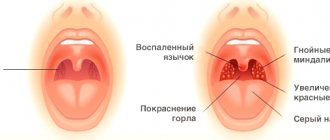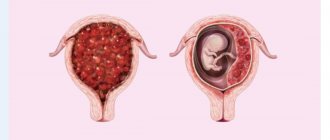Local therapist
Efimova
Natalia Vladimirovna
20 years of experience
District doctor-therapist of the first category
Make an appointment
Adenoviral infection is a pathological process that occurs when an adenovirus (Adenoviridae) enters the human body. The disease is accompanied by damage to the respiratory system, eyes, gastrointestinal tract and lymphatic system. Infected patients suffer from intoxication, fever, loss of voice, cough, and intestinal disorders. The diagnosis is made based on the clinical picture of the disease and the results of laboratory tests. During the treatment process, adults and children receive antiviral drugs, immunomodulators and drugs that relieve acute symptoms of infection.
General information about pathology
Adenovirus belongs to the group of respiratory viral infections. The course of the disease is complicated by conjunctivitis, nasopharyngitis, lymphadenopathy, and dyspeptic syndrome. The share of adenoviral infections in the overall structure of ARVI reaches 20%.
The risk group includes patients aged six months to three years. Almost all preschool children have been infected with adenovirus at least once. The pathology does not have a pronounced seasonality: the incidence rate remains stable throughout the year. Treatment of the disease is carried out under the supervision of a pediatrician and otolaryngologist.
Symptoms of adenoviral infection in children and their frequency of manifestation
Once in the child’s body, the virus enters the stage of the incubation period, that is, maturation. For 4 to 14 days, more often 5-7 days, the child may not show any signs of the disease. The disease manifests itself acutely or increases gradually.
External symptoms that any doctor can identify include2:
- Copious mucous discharge from the nose;
- Flushing of the pharynx or redness of the mouth;
- Swelling of the tongue;
- Development of pharyngitis;
- Change in the appearance of the tonsils;
- Red eyes and conjunctivitis;
- Increasing intoxication of the body - lethargy, weakness, headache, loss of appetite and nausea;
- Diarrhea, especially in young children;
- Temperature rises to 38–38.5° C.
After many years of studying various manifestations of acute respiratory viral infections, including adenovirus infection, doctors have deduced the frequency of occurrence of certain symptoms, which may indicate a specific virus.
- The most common symptom is fever, which occurs in 96% of cases.
- In 88% of cases with adenovirus infection, pharyngitis develops, and its duration is on average 5 days.
- Cough occurs in 78% of children with adenovirus. The likelihood of a dry and wet cough is approximately the same.
- In 67% of cases, rhinitis with mucous discharge from the nose is observed.
- Enlargement of the cervical lymph nodes is observed in 60% of patients.
- When listening to the lungs, wheezing is detected in 36% of cases.
- In 28% of children, there is a slight enlargement of the tonsils.
- A third may experience complications. The inflammatory process can develop into bronchitis, laryngotracheitis and pneumonia.
- Conjunctivitis is quite rare, but a clear sign of adenovirus infection, which occurs in every fifth person.
- Intestinal disorders have been reported in 22% of children, with a clear predominance in early childhood, in newborns and up to three years of age3.
Parents should pay attention to three stages of symptoms in their child, which are listed in the memo below. After the first segment, you need to seek medical help:
- The first manifestations of adenoviral infection. The child developed a fever, stopped being active, and began complaining of headaches.
- Distribution to all respiratory organs. Coughing, wheezing, sore throat appear, shortness of breath, runny nose occurs, and the child’s voice changes.
- Further progression of the disease. The eyes turn red, and the mucous membrane becomes inflamed (conjunctivitis), and gastrointestinal problems, diarrhea and vomiting may begin.
The following forms are distinguished according to severity:
- A mild form of the disease involves mild symptoms and a slight increase in temperature. In most cases, the disease subsides within a week.
- The moderate-severe form is characterized by severe symptoms of intoxication, fever and chills. The temperature reaches 38° C or more, the disease lasts a long time and complications are possible.
- In severe cases of the disease, the child’s body is subjected to a serious test. The disease almost always leads to complications - bronchitis develops, the liver can increase in size. With this type of disease, hospital treatment will likely be required.
Reasons for the development of pathology
Virologists have identified three dozen pathogens belonging to the Adenoviridae family. Infectious agents are adapted to long-term survival in unfavorable conditions and tolerate freezing temperatures and low environmental humidity. The DNA of pathogens is destroyed by ultraviolet radiation and chlorine-based chemicals.
Infected patients spread pathogens by secreting nasopharyngeal mucus. A significant number of viral agents are contained in feces. The main routes of infection for healthy people are airborne and fecal-oral. Swimming pool visitors can become infected after contact with water in which a carrier of the pathogen has swam.
A patient who has had an adenovirus infection is immune to a certain type of virus. A child or adult may become ill again when exposed to a carrier of a different Adenoviridae serotype. A similar mechanism of transmission of adenovirus from person to person is typical for nosocomial infections.
What is adenovirus
What if they told you that the same group of viruses can cause everything in the world, from the common cold to bladder infections? A bit strange, isn't it? And this is definitely not the news that I would like to hear on the eve of cold and flu season (for which we apologize).
However, it is true: members of a group of pathogens called adenoviruses can be deadly in some cases. Correspondent for the website " Health"
" turned to an infectious disease expert for clarification on what adenoviruses actually are, what symptoms they can cause and how they can be cured.
And here's what you need to know.
According to information materials from the Centers for Disease Control and Prevention (CDC), adenoviruses are a group of common viruses that can cause a wide range of diseases, including the common cold, stomach flu, sore throat, bronchitis, diarrhea, conjunctivitis, fever - in short, all diseases that occur with moderate symptoms and, as a rule, treatable at home. However, some strains of adenoviruses lead to more serious problems, such as urinary tract infections or pneumonia.
Since adenoviruses are extremely diverse, the symptoms they cause also vary widely. Mainly, respiratory diseases and conjunctivitis develop. This means that adenoviruses are responsible for most reported cases of coughing, wheezing and itchy red eyes.
The difference between adenoviruses and other viruses (for example, the influenza virus) is that the former do not necessarily prefer the cold season. “Adenoviral infections are seen year-round,” says Frank Esper , MD, a pediatrician who specializes in infectious diseases at the Cleveland Clinic. “The adenovirus likes summer no less than winter.”
The most common way an adenovirus infection spreads is through direct contact, such as touching, coughing, sneezing, shaking hands, or through touching a contaminated surface and then touching your own mouth, nose, or eyes. Less commonly, adenoviruses spread through infected feces (when changing a diaper for a sick child, for example) or through water (in public swimming pools, etc.).
“Can adenoviruses pose a threat to life? – In some cases, yes. An 18-year-old college student at the University of Maryland died from an adenovirus infection during the 2021 outbreak, which sickened 40 students and hospitalized 15 of them.”
“As a rule,” continues Dr. Esper , “those with weakened immune systems are at risk. If you have little to no immunity, then adenovirus becomes a really serious problem.”
This is exactly what happened to the deceased girl, who, according to the Washington Post
", suffered and struggled with Crohn's disease, a type of chronic intestinal inflammation, constantly taking maintenance medications in connection with this disease (certain groups of medications - used, in particular, to control Crohn's disease and treat cancer - in individual cases can become cause of immunodeficiency).
However, adenoviruses can become dangerous even for individuals with a normally functioning immune system. Whether this happens or not depends on the specific complications of the adenovirus infection. “Say, viral myocarditis, i.e. “Inflammation of the heart muscle,” explains Dr. Esper , “can develop in an immunocompetent person, and this complication can be fatal.”
“Is there a treatment for adenoviruses? “No, specific therapy for adenoviral infections has not yet been developed, and over-the-counter medications used in these cases only serve to relieve symptoms (i.e., to eliminate pain or fever, reduce temperature, etc.).”
In this regard, we have to repeat that the best remedy against adenoviral infections is their prevention. This means frequent and thorough hand hygiene, avoiding eating or drinking from shared utensils with the contagious person, and avoiding anyone who is openly coughing or sneezing (it might be worth reminding them to at least use your elbow, please).
In extreme cases, a drug called cidofovir is used, but again, it is prescribed extremely rarely. According to F. Esper, “the drug is very toxic; it itself can cause a serious condition, for example, kidney failure. We usually refrain from etiotropic treatment of adenoviruses and resort to wait-and-see tactics. The patient must be in a very serious condition for these medications to be prescribed.”
In general, for a healthy person, adenoviruses should not be a particular problem - however, it is wise to take all precautions and, if you do become ill, to protect those close to you with a sanitary and hygienic regime.
Based on materials from the Health website
Symptoms of pathology
Symptoms of adenovirus entering the human body are specific and depend on the form the infection has taken. If the respiratory tract is damaged, pharyngitis, tonsillopharyngitis and bronchitis can develop. If the infection penetrates the tissues of the conjunctiva, patients suffer from pharyngoconjunctival fever and acute conjunctivitis. The entry of viruses of the Adenoviridae family into the intestinal mucosa provokes the development of diarrhea syndrome.
Patients may experience mild, moderate, or severe disease. In some cases, the pathology is complicated by the addition of a secondary infection. The incubation period lasts from five to seven days. Upon completion, the patient feels a sharp increase in body temperature (up to 38–39 degrees). Later, typical signs of adenovirus infection appear:
- decreased appetite;
- apathy, lethargy;
- muscle and joint pain;
- fever;
- dehydration.
The listed symptoms of adenovirus develop in children and adults within several hours after the temperature rises. Without treatment, patients' condition quickly deteriorates.
Causes of adenovirus infection
Adenoviruses spread through the air, meaning you can become infected if someone in your neighborhood sneezes or coughs. At the same time, the picture of the disease in the carrier of the infection does not have to be pronounced; the disease can occur in a blurred form. In this case, the adenovirus can be released within two weeks from the onset of the disease.
Another route of spread of adenoviral infection is fecal-oral. This mechanism of infection is typical for children who cannot independently monitor personal hygiene and cleanliness of their hands. Adenoviruses are excreted in feces for one and a half months.
The household route is also possible, when adenoviruses are transmitted through household items.
The gate through which the infection enters the body is the mucous membrane of the upper respiratory tract; penetration through the conjunctiva, the transparent mucous membrane of the eye, is also possible. The adenovirus infects mucosal cells, multiplies in them, from where it enters the blood and spreads throughout the body.
Conjunctival damage
Reproduction of viruses in the tissues of the conjunctiva leads to the development of conjunctivitis of various forms: catarrhal, follicular and membranous. The pathological process begins to develop in one eye, but gradually affects the second. Patients complain of pain, burning, and foreign body sensation. An ophthalmological examination reveals redness and swelling of the skin of the eyelids. In some cases, doctors record the formation of a dense whitish film on the conjunctiva. Advanced adenovirus infection is complicated by keratitis.
Treatment of pathology
The medication course prescribed by doctors against the background of a confirmed diagnosis is based on antiviral drugs. Inpatient or outpatient treatment of people suffering from adenovirus involves the prescription of eye drops, ointments (applied to the eyelid), antipyretics and antitussives. If the respiratory system is affected, the patient will require regular inhalations and expectorants. Treatment of complicated adenovirus in children and adults may require the use of antibiotics.
Treatment methods for adenovirus infection
Treatment of adenovirus infection is carried out at home, except in cases of severe disease or development of complications. Since adenovirus infection is a contagious disease, the patient must be isolated (it is especially important to exclude the possibility of contact with children).
In most cases, adenovirus infection resolves within a week. A runny nose can last up to 3 weeks.
It is worth remembering that complications in children, especially young children, can develop very quickly. Therefore, in case of any increase in symptoms (deterioration in the child’s well-being, coughing, complaints of ear pain, etc.), it is necessary to consult a doctor.
Bed rest
During the period of elevated temperature, the patient must be provided with bed rest. It is not recommended to bring down a low-grade fever.
Symptomatic treatment
Since the disease is caused by a virus, antibiotics are not used (they do not work against viruses). The use of antibiotics is appropriate only in case of complications (if a bacterial infection has joined the viral infection). Treatment of adenovirus infection is symptomatic. The doctor will prescribe medications that relieve inflammation of the upper respiratory tract, eliminate nasal congestion and symptoms of conjunctivitis.
Taking vitamin supplements
Vitamins, primarily vitamin C, are prescribed as general strengthening therapy.
Make an appointment Do not self-medicate. Contact our specialists who will correctly diagnose and prescribe treatment.
Rate how useful the material was
thank you for rating
Forecast and preventive measures
With an uncomplicated course of the disease, patients achieve complete recovery in five to seven days. A complicated form of adenoviral infection may require hospitalization of a child or adult. In this case, the recovery time increases by 1.5–2 times.
If there is a sharp increase in adenovirus infection in kindergartens or schools, doctors recommend specific prevention. Virus carriers must be referred for outpatient or inpatient treatment. All premises of educational institutions should be treated with antiseptic solutions.
Why do adenovirus infections most often affect children?
During the first 6 months of life, children practically do not suffer from adenovirus infection. This is due to the fact that at this age children have passive immunity, inherited from their mother. Then innate immunity is lost, and children begin to get sick.
Until the age of 7 years, a child manages to get sick with adenovirus infection several times. Each time the body develops specific immunity to a specific type of adenovirus, but since there are several of them, the child has to get sick more than once. After 7 years, as a rule, they already have acquired immunity to all types of adenoviruses, and they are no longer afraid of adenovirus infection.
Over time, immunity is lost, so adenovirus infections can also affect adults.







